WHAT IS GERMINATION TESTING?
Germination testing evaluates the germination potential, or viability, of a seed. We are testing the percentage of seeds that germinate. We test raw seeds once a year, and pelleted seeds every 6 months.
WHY DOES OSBORNE SEED VALUE GERMINATION TESTING?
Germination testing is an important facet of our quality control program. We can prevent mistakes and mitigate problems by ensuring seed viability. If a grower has a problem with their seed, we can look back at our records with confidence to help them find a solution.
It’s our job to give our growers the best product that we have the ability to supply. That’s why we have systems and processes in place to ensure that that happens. Germination testing is only a small portion of our quality control. Our trialing process also helps us to determine if we should continue to supply certain varieties of seed, or try something new.
Our internal germination standards help growers receive quality seeds that will yield the expected crop. We hold our standards higher than what the Federal Seed Act requires in that our goal is to source seed with a high germination rate good vigor.
WHAT IS THE FEDERAL SEED ACT?
The Federal Seed Act (FSA) is an Act used to “… regulate interstate and foreign commerce in seeds; to require labeling and to prevent misrepresentation of seeds in interstate commerce; to require certain standards with respect to certain imported seeds; and for other purposes. Be it enacted by the Senate and House of Representatives of the United States of America in Congress assembled, that this Act may be cited as the “Federal Seed Act” (FEDERAL SEED ACT1 (7 U.S.C. 1551-1611).
In other words, the FSA holds seed companies to specific regulated standards to ensure that farmers receive seed that will produce productive crops.
The FSA also states in section §201.6 (Germination) that “The complete record shall include the records of all laboratory tests for germination and hard seed for each lot of seed offered for transportation in whole or in part. The record shall show the kind of seed, lot number, date of test, percentage of germination and hard seeds, and such other information as may be necessary to show the method used.”
WHAT ARE THE STEPS IN THE GERMINATION TESTING PROCESS?
The steps of our germination process include:
Sampling: We pull 100 seeds from each lot of each variety.
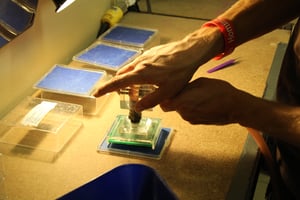
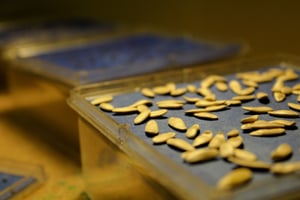
Place seed on blotter paper: The seeds are placed on these blotters because the moist environment helps the seed sprout.
Label: We label each blotter we germinate to ensure we always know which seeds are which while testing.
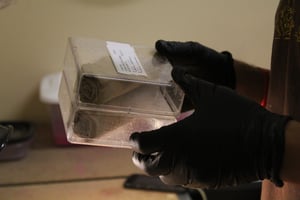
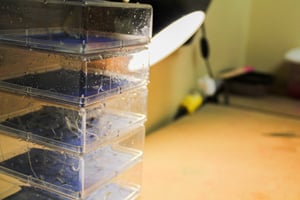
Place in germinator OR in a lit room: The purpose of a germinator is to provide consistent temperature growing conditions for the seed to sprout. Temperature and moisture are often the most critical factors for germination. Generally speaking, most vegetable and herb seeds do not need light to germinate, though it does become important as the seedling begins to grow. Light will not harm the sprouting seed. If you do not have a germinator handy, a somewhat temperature-consistent room will suffice.
The difference between the germinator and a lit room is that some seeds require different conditions to grow. Meaning, certain crops could need more light than others in order to flourish and a lit room would provide that in comparison to the germinator.
Wait the allotted germination time per variety: This wait time process can be between 3 and 28 days depending on how long certain seeds take to sprout. Consistent temperature and moisture will speed up this process.
Sprout Counting: Of the 100 seed germinated, we count how many sprouted to determine the percentage germination rates. For example, if we germinated 100 lettuce seeds and 88 sprouted, we would have a germination rate of 88%. To satisfy our high quality standards, we subtract 3% to account for the possibility of human error.
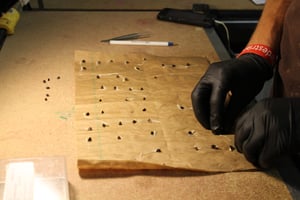
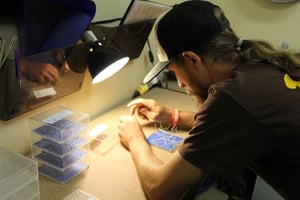
HOW LONG DOES THE GERMINATION TESTING PROCESS TAKE?
This process can range between 6 days and 4 weeks from start to finish. Example time frames are listed as follows.
Radish (Raphanus sativus): 6 days
Lettuce (Lactuca sativa): 7 days
Broccoli (Brassica Oleracoa Botrytis): 10 days
Parsley (Patroselinum Crispum): 28 days
GERMINATION STANDARDS
At Osborne Quality Seed, we hold our seeds to high standard. We have germination minimums for all crops. If seeds do not meet this minimum, we provide an overpack. This is additional seed, usually between 5% and 25% of the weight or seed count, included at no additional cost to the grower to meet ours and growers’ expectations and standards.
KEY WORDS TO UNDERSTAND:
Germination: The process of germination is the sprouting of a dormant seed into a seedling.
Blotter Paper: Paper used to maintain a moist environment to aid in the growth from a seed to a sprout when testing the germination rate.
Pelleted Seed: Pelleted seeds are coated with material (“pelletized”) to make them more uniform and round for easier handling when seeding.